Brigham Young University Choir & Orchestra – Oh Come All Ye Faithful
An evening pause: I hope all my Christian readers had a wonderful and joyous Christmas, from your Jewish but very secular host. With good will to all!
Hat tip Judd Clark.
An evening pause: I hope all my Christian readers had a wonderful and joyous Christmas, from your Jewish but very secular host. With good will to all!
Hat tip Judd Clark.
A mid-day pause: As I now do practically every Christmas, I bring you the classic 1951 version of Charles Dickens’ A Christmas Carol, starring Alastair Sim. In my opinion still by far the best adaption of the book and a truly wonderful movie.
And as I noted in a previous year:
Dickens did not demand the modern version of charity, where it is imposed by governmental force on everyone. Instead, he was advocating the older wiser concept of western civilization, that charity begins at home, that we as individuals are obliged as humans to exercise good will and generosity to others, by choice.
It is always a matter of choice. And when we take that choice away from people, we destroy the good will that makes true charity possible.
And in 2016 I said this:
I watched this again and felt like weeping, not because of the sentimentality of the story itself but because it is so seeped in a civilized world that increasingly no longer exists. There was a time when this was our culture. I fear it is no longer so. As noted by the Spirit of Christmas Present, “This boy is ignorance, this girl is want. Beware them both, but most of all beware this boy.”
It seems for the past few decades we have not heeded that warning, and are now reaping the whirlwind.
Link here. The article provides a very comprehensive list of the many former SpaceX employees who have left SpaceX to form their own companies, most of which in space or related industries, raising $3 billion in private investment capital.
The list includes a lot of very small operations doing work on the periphery, such as in the health industry or software for a variety of industries, not just space. It also includes some new major space players, such as the orbital tug company Impulse, and the recoverable capsule company Varda.
For some reason the article refers to this new generation of space entrepreneurs as the “SpaceX Mafia”, as if they are teaming up like mobsters to eliminate any competition. This is beyond false. Instead, they are the epitome of competition and the American dream, each forming their own company to push new ideas.
Take a look. It provides a nice and very hopeful overview of the future.
The Italian rocket company Avio has won a $81 million launch contract from Taiwan’s space agency TASA to use its Vega-C rocket to launch four Earth observation satellites.
FORMOSAT-8 will be a constellation of six high-resolution optical Earth observation satellites. The first was launched aboard a SpaceX Falcon 9 rocket in November. The next, FORMOSAT-8B, which does not yet have a publicly announced launch services provider, is, according to TASA, slated for launch in December 2026. The FORMOSAT-9 constellation will be made up of two synthetic aperture radar (SAR) satellites, which are expected to be launched in 2028 and 2030, respectively.
All four satellites will be launched aboard Vega C rockets from the Guiana Space Centre in French Guiana.
It is not clear if this contract involves four separate launches, or two (one for Formosat-8A and B, and a second for Formosat-9A and B). It is also not clear if this contract is one of the two launch contracts Avio had previously announced, without revealing the customers.
An evening pause: Another reprise, this time from 2020. As I wrote then: “This song honoring Jesus I think really speaks of every child born on Earth, and how every parent should see them. As Wordsworth said, they come ‘trailing clouds of glory.'”
Did you know that your baby boy has walked where angels trod?
When you kissed your little baby then you kissed the face of god.
According to this detailed update on SpaceX’s work at Boca Chica by NASASpaceflight.com, we should expect the next orbital test flight of Starship/Superheavy some time in March 2026.
As far as the launch date for this first flight of Block 3, sources point to March as the most likely viable timeframe. This launch will mark numerous firsts, from the vehicle, its Raptor 3 engines, and the first use of the upgraded Pad 2 architecture that will be mirrored at Pad 1, along with 39A and SLC-37 on the East Coast.
Block 3 refers to a major upgrade in Starship, which will fly prototype #39. Meanwhile, work getting Superheavy prototype #19 prepped has moved fast, following the loss of #18 from an explosion during ground fueling tests.
Recent observations show significant milestones: after welding the liquid oxygen (LOX) tank to the engine section (including pre-installed landing tanks and transfer tube), teams added methane tank barrels and the forward dome with its integrated hot staging ring. By December 20, all barrel sections were delivered and stacked, achieving this in just 25 days from November 25 — half the 42 days required for Booster 17, the final Version 1 booster.
The report also said that a February launch is a possibility, but is less likely.
Meanwhile, news outlets are reporting that the Trump administration is considering giving SpaceX about 775 acres in a wildlife preserve adjacent to Starbase in exchange for 692 acres SpaceX owns elsewhere. If confirmed, this deal would be similar to the land swap Texas had wished to do with SpaceX the company scrapped last year.
Last week the Italian rocket company Avio announced that it has signed launch contracts for its Vega-C rocket with two different unnamed satellite customers, the value of the contracts equaling $117 million total.
The satellites to be launched will be used for Earth observation, environmental monitoring and resource management purposes for civil and scientific applications, providing high-resolution imagery as well as best-in-class geolocation accuracy. The passengers will feature a mass ranging from more than 400 to more than 1,000 kilograms and will be deployed into a ~500 km Sun-synchronous orbit.
These contracts totally secure over EUR 100 million for launch services to be scheduled between 2028 and 2031.
Though the customers remain unnamed, the Avio release indicated that one was from Europe and the other was non-European. That latter contract deal could be linked to Avio’s announcement at about the same time that it is spending $500 million to build a rocket facility in Virginia. If the non-European customer was American and its satellites were for the Pentagon, having a U.S.-based facility made that contract award far more likely.
India’s space agency ISRO today (December 24 in India) successfully launched AST SpaceMobile’s sixth Bluebird satellite into orbit, its Bahubali rocket (LVM3) lifting off from its Sriharikota spaceport on India’s eastern coast.
This Bluebird is an upgrade from the first five satellites, providing ten times the bandwidth. The constellation acts as satellite cell towers for smart phones. These Bluebird satellites have been the largest in size ever launched, and this satellite will break their previous records. It is also the heaviest satellite India’s Bahubali rocket has ever put in orbit, on its sixth launch.
For India, this is its fourth launch in 2025. The leaders in the 2025 launch race:
168 SpaceX
86 China
18 Rocket Lab
15 Russia
SpaceX still leads the rest of the world in successful launches, 168 to 144.
An evening pause: I posted this Judd Clark suggestion previously in December 2023, but Judd sent it to me again and I agree, it deserves a reprise. It reminds us that despite all the craziness that has happened in the world in the past half century, children still see wonderful things we have forgotten exist.
According to a tweet by SpaceX yesterday, Starlink now has nine million active customers in 155 countries worldwide.
These numbers tell us the company is now getting more than a billion dollars per month in revenues, based on what it charges for its various plans. What make the numbers even more startling is how fast they are growing.
In a similar post from November 5, SpaceX said Starlink had 8 million customers, meaning that its customer base has expanded at a rate of more than 20,000 per day since that date.
At more than billion dollars per month, SpaceX essentially has about half the annual revenue of NASA, which it can use far more efficiently. And those numbers will only increase in the coming years, as the company opens up new markets worldwide and begins launching its upgraded Starlink satellites with Starship.
It still seems to me puzzling why, with these numbers, Musk is considering making the company public this coming summer. Though that move would bring in a gigantic amount of new investment capital from the stock sale, it would also subject the company to serious government regulation as a publicly-traded company. The Starlink revenue can only grow. Why add government interference when you can live without it?
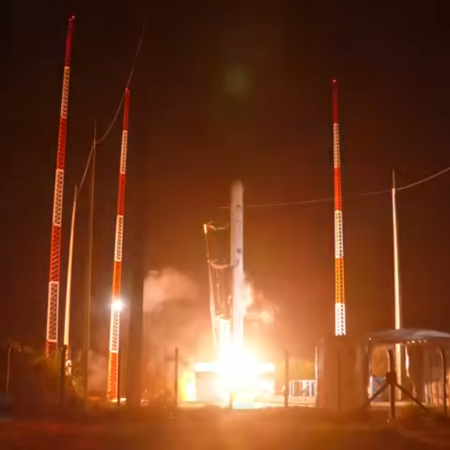
Though details are not yet available, the first launch by South Korean rocket startup Innospace of its Hanbit-Nano rocket failed less than 2 minutes after liftoff from Brazil’s long unused Alcantera spaceport. The failure occurred sometime after the rocket passed through max-q, the moment when the aerodynamic pressure of the atmosphere and the speed of the rocket stresses the rocket the most.
The live stream provided no details, other than to say “we experienced an anomaly during the flight.” No other details have yet been released.
The image to the right is a screen capture of the rocket lifting off the pad, less than a few seconds after T-0. Though the rocket appeared to move upward in a smooth controlled flight, soon thereafter it became impossible to see anything but the bright engine flame at its base. Either the flames were so bright it overexposed the live stream, or the fire was spreading beyond the nozzles. At the moment however we know nothing about what happened.
An evening pause: One of the most beautiful sections of Handel’s masterpiece, often missed because it is quiet and gentle in tone.
According a brief announcement today from Robert Lightfoot (ULA Lockheed Martin Board Chair) and Kay Sears (ULA Boeing Board Chair), Tory Bruno has resigned as CEO and president of United Launch Alliance, effective immediately.
After nearly 12 years leading United Launch Alliance (ULA), current ULA President and CEO Tory Bruno has resigned to pursue another opportunity.
We are grateful for Tory’s service to ULA and the country, and we thank him for his leadership.
Effective immediately, John Elbon is named as the Interim CEO. We have the greatest confidence in John to continue strengthening ULA’s momentum while the board proceeds with finding the next leader of ULA. Together with Mark Peller, the new COO, John’s career in aerospace and his launch expertise is an asset for ULA and its customers, especially for achieving key upcoming Vulcan milestones.
No further information was provided.
The timing is intriguing, as after a decade of effort, Bruno was about to get ULA’s new Vulcan rocket launching on a regular basis. I could speculate, but at the moment there isn’t enough information to make even a good guess.
Hat tip to reader Gary.

Chicken Little gains support!
It appears the political opposition by local politicians and activists against renewing Blue Origin’s wastewater permit for its Florida rocket facilities is growing, and could result in major delays for the company.
Four weeks ago, Cocoa Beach Realtor Jill Steinhauser launched an online petition opposing Blue Origin’s draft permit to discharge wastewater into the Indian River Lagoon, writing that “decades of nutrient pollution, algae blooms, seagrass collapse, habitat loss, and record manatee deaths have pushed this fragile ecosystem to the edge.” Since then, Space Coast buzz has significantly grown opposing Blue Origin’s permit-renewal bid to operate a 490,000-gallon-per-day industrial wastewater treatment facility at its massive rocket manufacturing plant just south of the Kennedy Space Center Visitor Complex.
And on Thursday, Dec. 18 — the Florida Department of Environmental Protection’s deadline date for public comment — Steinhauser submitted 43,475 verified petition signatures to the state agency.
A five-year permit had first been issued in 2020, and now needs to be renewed. Steinhauser’s campaign has apparently caught the interest of local Democratic Party politicians, who see another great way for them to to block another American success. In early December the Democrats on the Brevard county commission came out against renewing the permit, and followed up with an official vote of opposition shortly thereafter. This was then backed by the Cape Canaveral City Council on December 16th. That same week “eight Democratic state legislators signed a letter opposing Blue Origin’s draft permit.”
It appears that unlike SpaceX’s closed loop system, Blue Origin’s system is open-looped, which carries the possibility that its system can overflow into the Indian River Lagoon. However, officials from Florida’s Department of Environmental Protection (DEP) note that the system has more than ample capacity to avoid such an overflow.
The facility’s flow averages about 40,000 gallons per day, which is less than 10% of the maximum limit. The industrial wastewater covered by the permit does not come into contact with fuel or other hazardous materials, and it is discharged into a 9¼-acre stormwater retention pond. If the pond reaches its designed holding capacity during heavy rainfall, it overflows through a 3-mile-long drainage ditch along Ransom Road before eventually reaching the lagoon.
Though it is likely that this opposition will fail in the end, it could cause a delay in the permit renewal. If that happens, Blue Origin might find its launch plans for 2026 seriously hampered.
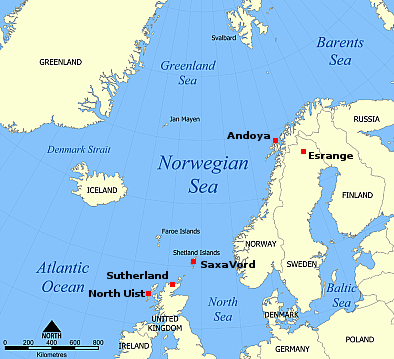
Spaceports surrounding the Norwegian Sea
The third proposed spaceport in Scotland, located on the northwest coast of the island of North Uist (as shown on the map to the right) has now received a conditional airspace approval by the United Kingdom’s Civil Aviation Authority (CAA).
While the airspace is designated as permanent, it will not be restricted indefinitely. Instead, it will be “activated by Notice to Aviation (NOTAM)” only when launch operations are scheduled to occur. The CAA noted that the approval is “subject to conditions” that the change sponsor must satisfy before the airspace can be fully utilised. Detailed regulatory assessments and the specific list of conditions are expected to be published on the CAA’s Airspace Change Portal shortly.
The spaceport’s airspace is set to become legally effective on Thursday, January 22.
Based on the CAA’s past behavior, this approval means very little. It will still require long lead times to issue any specific launch approvals, making any planned launches at this spaceport as difficult as all the other spaceports that have attempted to lift off from Great Britain. Those red tape delays put Virgin Orbit out of business. It has caused Orbex to abandon the Sutherland spaceport, which increasingly looks like a dead project. And it has caused numerous other small rocket startups to look everywhere else but Great Britain for a launch site.
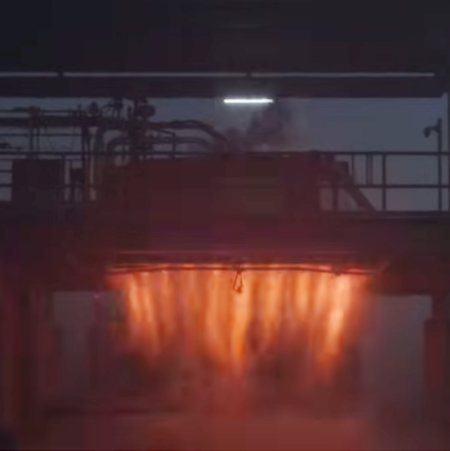
Tim Dodd of Everyday Astronaut yesterday released a long video in which he got a new tour the Stoke Space facility, led by the company’s CEO and founder, Andy Lapsa.
I have embedded that video below. The image to the right is a screen capture of a static fire test of the company’s Nova rocket’s upper stage engine that was done at the end of the tour. The engine uses a radical design of a ring of small nozzles, with a heat shield in the middle. The design aims to allow that upper stage to return to Earth for reuse, after it has deployed its payload. Nova’s first stage will also be reusable, landing vertically like the Falcon 9.
Though as usual Lapsa said nothing about schedule, it appears that the company is getting very close to its first launch. It appears the company’s launchpad in Florida will be ready for launch early in 2026. It also appears that all the rocket’s components are falling into place.
Lapsa noted that though both stages are designed to land and be reused, the goal for that first launch is simply to demonstrate they can get the rocket into orbit. Neither stage will attempt a landing. Once they’ve got that success under their belt, they will then go for other milestones.
Right now only SpaceX and Stoke Space are working to build a completely reusable rocket. SpaceX is going very big, with Starship. Stoke is aiming for the Falcon 9 market. If successful, it will be able to beat that rocket in price.
» Read more
More business for rockets! The internet satellite company Eutelsat/OneWeb now has plans to launch another 340 satellites by 2027, partly to replace aging satellites but also to upgrade its constellation.
Eutelsat OneWeb plans to deploy a constellation of over 340 satellites for its second-generation (Gen-2) low-earth orbit (LEO) network by 2027, as it looks to strengthen its business-to-business (B2B) and business-to-government (B2G) offerings globally. Neha Idnani, Regional Vice President for Asia Pacific at Eutelsat OneWeb, told Business Today in an exclusive interaction that the company is gearing up for the next phase of its orbital expansion to boost network capacity, resilience and coverage worldwide.
OneWeb began deploying its Gen-1 satellites in 2019 and operates a constellation of around 640 satellites as of 2025. While the network is fully operational, close to 100 satellites from the initial fleet are due for replenishment. The Gen-2 rollout will mark a shift to a more advanced and flexible network architecture.
The article at the link touts India’s space agency ISRO as a likely launch provider for those missions, which isn’t surprising as a substantial percentage of Eutelsat/OneWeb is owned by an Indian investor. It is also likely however that other companies, including SpaceX, Blue Origin, and Rocket Lab, will be considered also.
Rocket Lab this evening successfully completed its 7th launch of a radar satellite for Japanese company Q-Shu Pioneers (iQPS), its Electron rocket lifting off from one of the two launchpads in New Zealand.
Q-Shu has signed Rocket Lab to do eleven launches total, so expect four more launches next year.
In 2025 Rocket Lab also completed three launches of its HASTE version of Election, which is designed to do suborbital hypersonic tests for the Pentagon. If we count these, the company has completed 21 launches in 2025. And even if we don’t count these suborbital launches, Rocket Lab has now launched more times than any other private company, except for SpaceX.
The leaders in the 2025 launch race:
168 SpaceX
85 China
18 Rocket Lab (a new record)
15 Russia
SpaceX still leads the rest of the world in successful launches, 168 to 142.
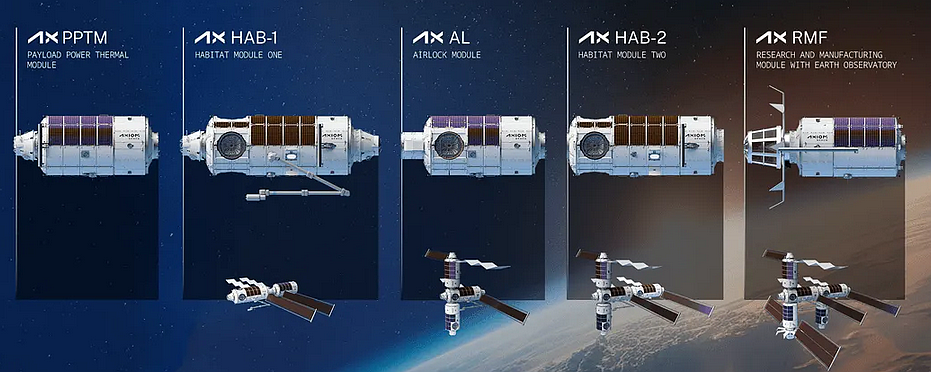
Axiom’s assembly sequence for its planned station, initially attached to ISS but subsequently detached
The space station startup Axiom has now obtained a $100 million investment by the Hungarian communications provider 4iG.
The company said Dec. 19 it has committed to invest $30 million in Axiom by the end of 2025, followed by an additional $70 million by March 31, 2026.
In October, 4iG announced a non-binding commitment letter to evaluate a potential $100 million investment in Axiom Space. The agreement outlined a separate $100 million framework for cooperation on the development of orbital data center systems over the next five years. 4iG said in a news release that the Axiom investment would provide Hungary with an opportunity to secure a long-term role in orbital data centre programs and space-based data processing and storage, but did not provide details.
In 2024 there were rumors the company had a serious cash shortage, though since then construction of its first two modules has proceeded as planned, with a launch of the first module still set for sometime in 2026. This new infusion of cash should shore up Axiom’s station construction considerably.
My rankings of the commercial space stations now under development:
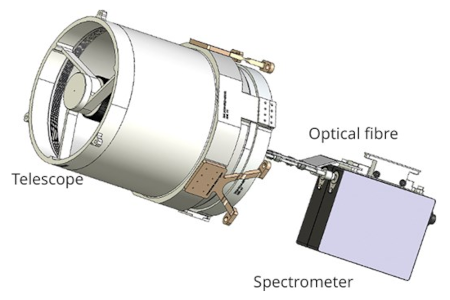
Mauve space telescope. Click for source.
Capitalism in space: A new commercial optical space telescope with a 5-inch-wide mirror and dubbed the Mauve Telescope is now operational in orbit, with its private owner, UK startup Blue Skies, offering its data to scientists for an annual subscription fee.
Blue Skies is in the process of commissioning the Mauve and plans to start delivering data to scientists in early 2026. Customers include Boston University, Columbia University, INAF’s Osservatorio Astrofisico di Arcetri, Konkoly Observatory, Kyoto University, Maynooth University, the National Astronomical Observatory of Japan, Rice University, Vanderbilt University, and Western University.
The spacecraft’s three-year mission is to study flares from stars and their impact on the habitability of planets around them. From low Earth orbit, it hosts a telescope that can collect data in the ultraviolet to visual light range (200-700 nm spectrum).
With such a small mirror Mauve is not going to be able to do a lot of ground-breaking work, though there are definitely observations of value it can accomplish, such as those listed above. Its main purpose is as a demonstration project to attract a bigger round of new investment capital, from universities like the ones listed above, for launching a larger private telescope with greater capabilities.
This is how all telescopes were funded in the U.S. until World War II, through private funds privately built. Blue Skies effort here suggests we are heading back to that model, with government budgets increasingly constrained. The company is already working on a second and larger space telescope, dubbed Twinkle with a 18-inch primary mirror. It hopes over time to continue to scale up its orbital telescopes until it is matching Hubble and Webb, and doing so faster and at far less cost.
And for profit no less!
According to an update yesterday by SpaceX on X, one of its many Starlink satellites is now tumbling with its fuel tank venting, and is thus losing altitude.
On December 17, Starlink experienced an anomaly on satellite 35956, resulting in loss of communications with the vehicle at 418 km. The anomaly led to venting of the propulsion tank, a rapid decay in semi-major axis by about 4 km, and the release of a small number of trackable low relative velocity objects. SpaceX is coordinating with the @USSpaceForce and @NASA to monitor the objects.
The satellite is largely intact, tumbling, and will reenter the Earth’s atmosphere and fully demise within weeks. The satellite’s current trajectory will place it below the @Space_Station, posing no risk to the orbiting lab or its crew.
Either the tank burst, or got hit with something causing it to burst.
The media reports I’ve seen have tried to make this event more significant than it is. First, it is remarkable how few of SpaceX’s thousands of Starlink satellites have failed in this manner. These low numbers show how this incident is rare and not very concerning. Second, the spacecraft’s orbit is decaying, and will soon burn up harmlessly in the atmosphere. It will not add any space junk to low Earth orbit.
In fact, that this event illustrates more than anything how well SpaceX manages its Starlink constellation. Thousands of satellites launched, and only a handful have failed like this.
An evening pause: Performed live 2013. I know this song is a bit over-played this time of year, but this performance brings a freshness to it well worth experiencing. And it is about what Christmas actually celebrates.
Hat tip Judd Clark.
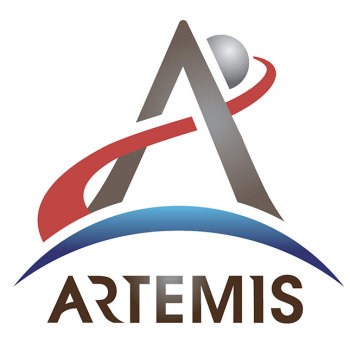
Change is coming to Artemis!
The White House today released a new executive order that has the typically grand title these type of orders usually have: “Ensuring American Space Superiority”. That it was released one day after Jared Isaacman was confirmed as NASA administrator by the Senate was no accident, as this executive order demands a lot of action by him, with a clear focus on reshaping and better structuring the entire manned exploration program of the space agency.
The order begins about outlining some basic goals. It demands that the U.S. return to the Moon by 2028, establish the “initial elements” a base there by 2030, and do so by “enhancing sustainability and cost-effectiveness of launch and exploration architectures, including enabling commercial launch services and prioritizing lunar exploration.” It also demands this commercial civilian exploration occur in the context of American security concerns.
Above all, the order demands that these goals focus on “growing a vibrant commercial space economy through the power of American free enterprise,” in order to attract “at least $50 billion of additional investment in American space markets by 2028, and increasing launch and reentry cadence through new and upgraded facilities, improved efficiency, and policy reforms.”
To achieve these goals, the order then outlines a number of actions required by the NASA administrator, the secretaries of Commerce, War, and State, as well as the Director of the Office of Management and Budget (OMB) and the Assistant to the President for Domestic Policy (APDP), all coordinated by the assistant to the President for Science and Technology (APST).
All of this is unsurprising. Much of it is not much different than the basic general space goals that every administration has touted for decades. Among this generality however was one very specific item, a demand to complete within 90 days the following review:
» Read more

Kenya spaceports
The Kenyan government has now initiated a project to establish a second commercial spaceport on the country’s coast, located near the town of Kipini.
As stated in the document made public on December 16, 2025, the government is looking to recruit a skilled transaction advisor who is capable of analyzing the technical, financial, legal, environmental, and social feasibility of the construction of the spaceport based on a PPP model. The strategy utilizes Kenya’s location on the equator, which provides some benefits in satellite launches, among them lower fuel consumption, lower launch costs, and easier satellite placement in low-inclined orbits around the earth’s equatorial region.
…Under the plan, the transaction advisor will prepare a detailed feasibility study in line with the PPP Act, 2021. The study will include concept designs, launch vehicle options, infrastructure requirements, lifecycle cost estimates, and a phased implementation plan for the facility.
As shown on the map to the right, this new facility would be to the north of the San Marco offshore platform that had been used for eight launches by Italy from the ’60s to the ’80s and that the Italian rocket company Avio is now planning to re-open.
The Kenyan government apparently wants to build its own a launch site that it can offer to others to use.
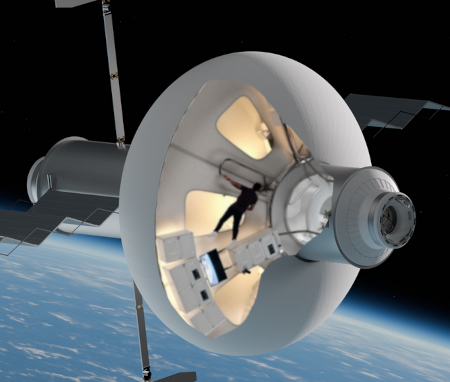
Thunderbird, with cut-out showing interior and person
for scale. Click for original images.
The startup Max Space yesterday unveiled a new larger and upgraded inflatable module, dubbed Thunderbird, that it proposes to sell to the various space stations being built in the U.S. and globally.
Thunderbird Station is built to support 4 or more crew members continuously, with an incredible 350m³ of pressurized volume, more than triple that of a standard ISS module. Launched on a single standard Falcon 9 rocket, the full expandable habitat launches compactly and expands 20x once deployed in orbit, requiring no in-orbit assembly. The interior features a novel reconfigurable architecture, morphic interior structure,that allows astronauts to dynamically adapt the space for research, manufacturing, or living during a mission. The design was developed in collaboration with veteran astronauts to take full advantage of three-dimensional volume in microgravity, not just traditional floor and wall space, to create the most spacious and functional habitable volume ever built. [emphasis in original]
The company also announced that it plans to fly a much smaller demonstration mission of this inflatable module design in the first quarter of 2027, launching on a Falcon 9 rocket and dubbed Mission Evolution.
The primary objective is to test and verify the on-orbit deployment of the expandable module with its exceptional micrometeoroid protection layers. After many years of successful ground testing and development, the flight unit is in full production and is scheduled for launch Q1 2027 onboard a scheduled SpaceX launch.
Max Space first appeared in 2024 when it announced its intention to fly an inflatable demo mission by 2025. Obviously that schedule has undergone some significant delays, though it appears the company used the time to refine its designs considerably. Its management includes one former NASA astronaut and one former member of the Bigelow space station team that built the first private orbiting inflatable modules, Genesis-1, Genesis-2, and BEAM (still operating on ISS).
The company is not trying to build its own space stations. Instead, it is marketing its inflatable modules to all the other space station startups as a quick way to get an additional large module added to their stations.
Hat tip to BtB’s stringer Jay.

Australian spaceports: operating (red dot) and proposed (red “X”)
Click for original image.
The South Korean rocket startup Innospace — about to attempt its first orbital launch from Brazil on December 19, 2025, earlier this week signed an agreement with Australia’s Southern Launch spaceport to launch its rockets from there.
Leading space mission service provider Southern Launch has signed South Korean launch service provider Innospace to conduct space missions from the Whalers Way Orbital Launch Complex and the Koonibba Test Range. This strategic partnership enables Innospce to conduct a diverse range of missions from Southern Launch sites, including orbital satellite launches and suborbital technology demonstrations.
Beginning in 2026 and continuing for at least the next decade, this agreement strengthens South Australia’s position as an emerging global hub for space innovation.
Whether or not its launch from Brazil’s long unused Alcantera spaceport is a success, it appears Innospace was looking for another spaceport option closer to South Korea. Moreover, Southern Launch has been an on-going active launch site for suborbital launches as well as a landing zone for spacecraft, unlike Alcantera which has sat unused for decades. That activity probably makes it a more viable place to operate.
Hat tip to BtB’s stringer Jay.
Rocket Lab tonight successfully placed into orbit a set of Space Force technology test satellites dubbed DISKSat, its Electron rocket lifting off from Wallops Island in Virginia.
DISKSat is a new standard satellite design, shaped like a flat disk about a yard across and developed by the Aerospace Corporation. The idea is that these disk-shaped satellites will more efficiently fit payload into the standard cylindrical fairings used by rockets. This mission includes four that will be deployed in low Earth orbit, but during the mission will also test operation in much lower orbits than satellites normally fly. I suspect the flat design reduces the atmospheric drag at those low orbits, thus allowing the satellite to remain in orbit for longer time periods.
The leaders in the 2025 launch race:
168 SpaceX
84 China
17 Rocket Lab (a new record)
15 Russia
SpaceX still leads the rest of the world in successful launches, 168 to 140.
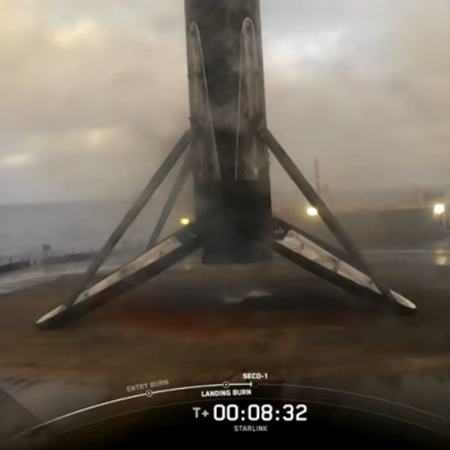
Falcon 9 1st stage after landing for 30th time
In the past twelve hours there was one launch abort at T-0 and three successful launches.
First, Japan’s space agency JAXA attempted to launch a GPS-type satellite using its H3 rocket, built by Mitsubishi. The countdown reached T-0 but then nothing happened. The launch was then scrubbed because of an issue in the ground systems. No new date was announced.
Next, Arianespace, the commercial division of the European Space Agency (ESA), launched two European Union GPS-type satellites, Galileos 33 and 34, its Ariane-6 rocket lifting off from French Guiana.
This was Arianespace’s seventh launch in 2025, the most it has achieved since 2021, though still about 20-30% lower than the numbers it generally managed in the 2010s.
Finally, SpaceX followed with two launches on opposite coasts. First, its Falcon 9 rocket launched 29 Starlink satellites from the Kennedy Space Center in Florida, the first stage completing its sixth flight by landing on a drone ship in the Atlantic.
Shortly thereafter the company launched another 27 Starlink satellites, its Falcon 9 rocket lifting off from Vandenberg Space Force Base in California. The first stage (B1063) completed its 30th flight, landing on a drone ship in the Pacific. This stage is now the third Falcon 9 booster to reach 30 reuses:
» Read more